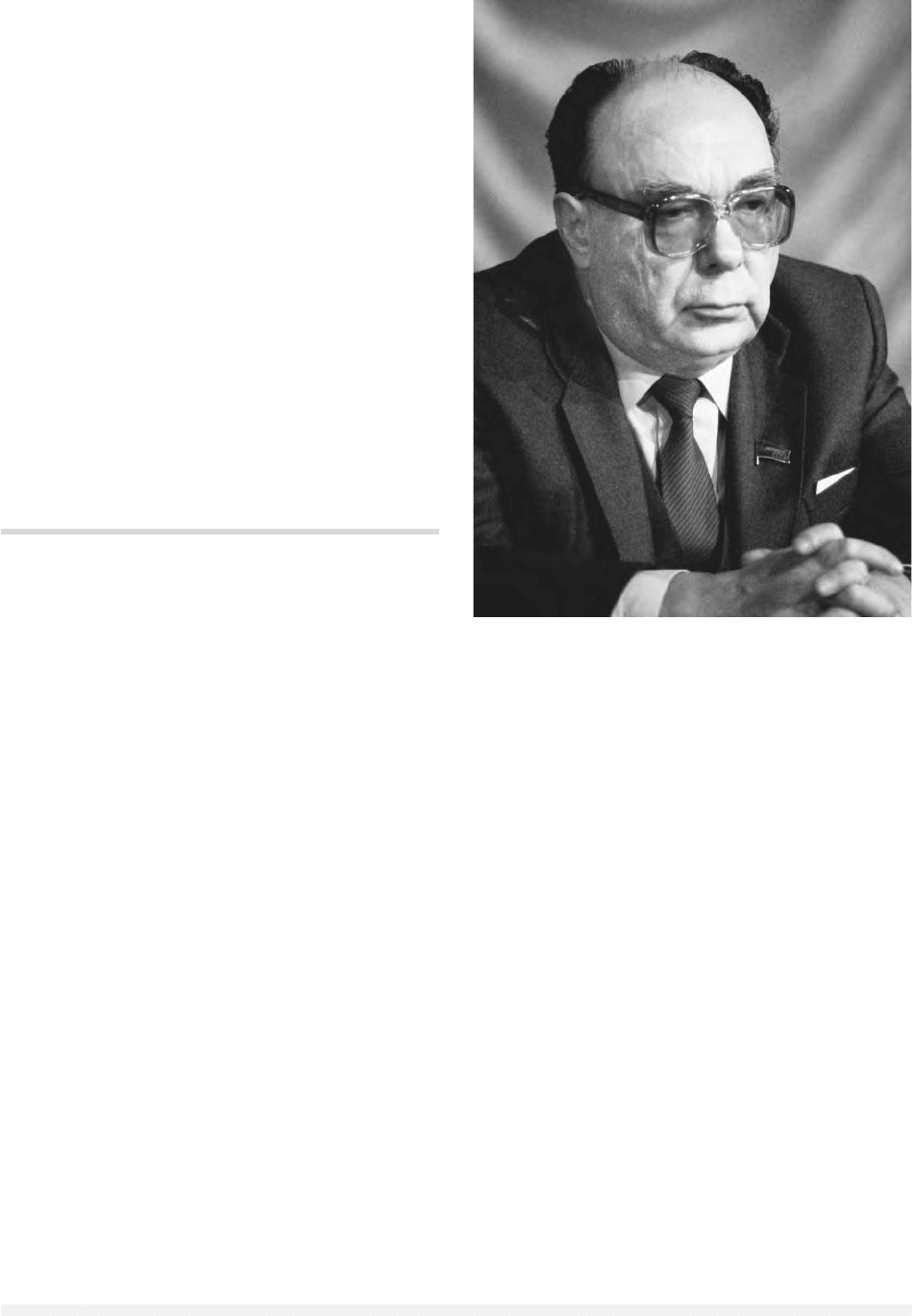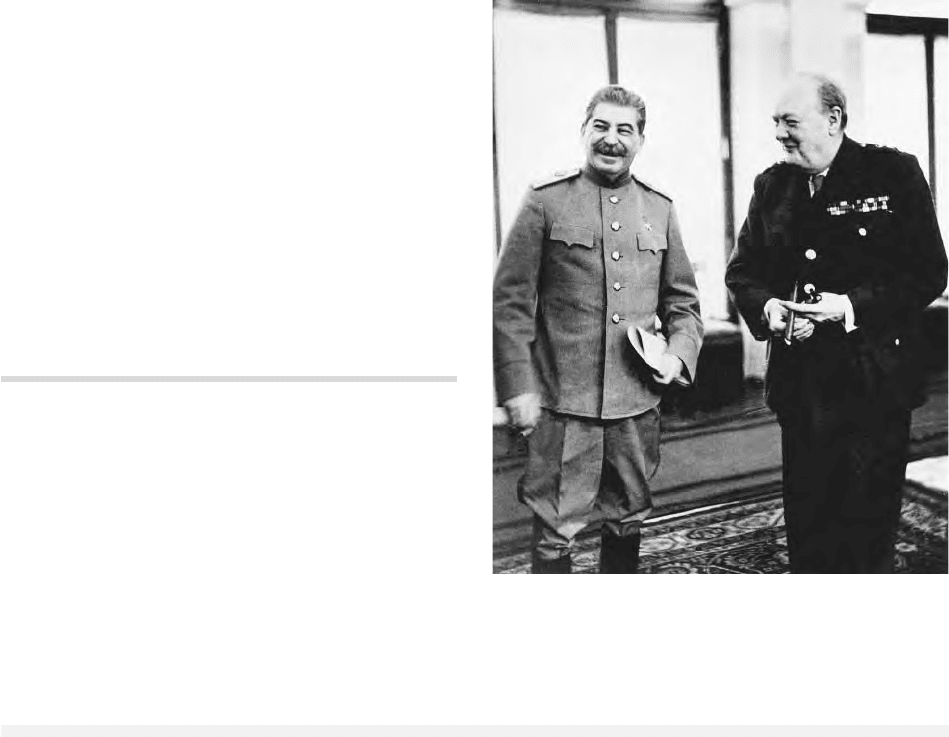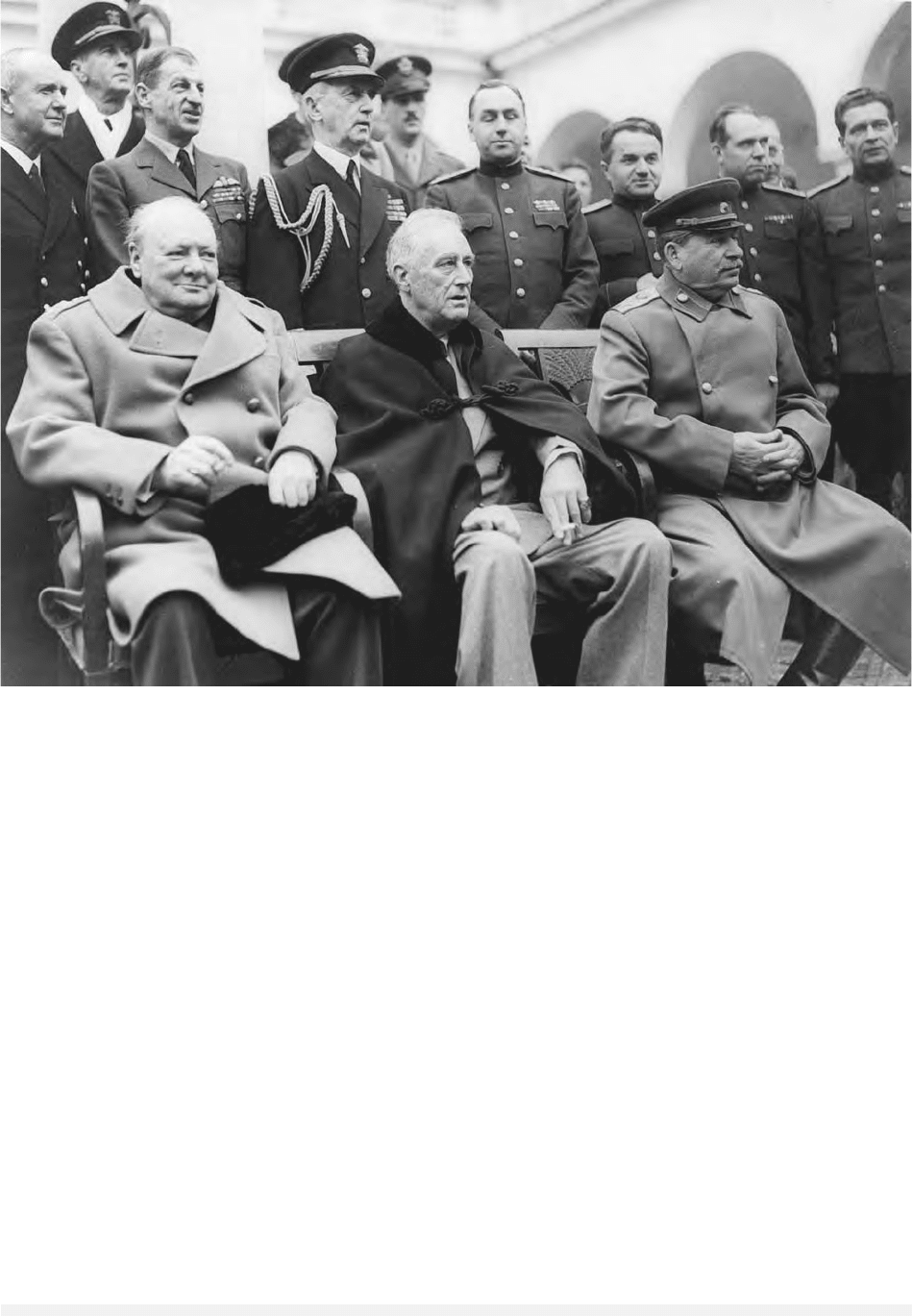Encyclopedia of Russian History
Подождите немного. Документ загружается.


for the liberal electorate with the pro-government
reform party (at first Russia’s Choice, then Union
of Right Forces). Party identification among
Yabloko voters was rather weak, and surveys in-
dicate that they were scattered across the entire po-
litical spectrum.
In the December 1995 Duma election Yabloko
maintained its position, finishing fourth with 6.9
percent of the vote, thirty-one seats on the party
list, and fourteen seats in single-mandate races.
Yabloko established a visible presence in the parlia-
ment through articulate young leaders such as Alexei
Arbatov, deputy chair of the defense committee.
In November 1997 Yabloko’s Mikhail Zadornov,
the head of the Duma’s budget committee, joined
the government as finance minister. In May 1999
Yabloko voted for impeaching Yeltsin because of
his actions in the first Chechen war. In August
1999 former prime minister and anticorruption
campaign Sergei Stepashin chose to join Yabloko
rather than the rival Right Cause. But in the De-
cember 1999 Duma elections Yabloko’s support
slipped to 5.9 percent (yielding sixteen seats, plus
four in the single mandates). It was probably hurt
by Yavlinsky’s criticism of the government’s new
war in Chechnya.
Yabloko mainly existed as a vehicle for its
leader, Yavlinsky. The rise of Vladimir Putin sunk
Yavlinsky’s presidential chances, leaving Yabloko
as a visible but relatively powerless voice of oppo-
sition.
See also: CONSTITUTION OF 1993; YAVLINSKY, GRIGORY
ALEXEYEVICH; YELTSIN, BORIS NIKOLAYEVICH
BIBLIOGRAPHY
Yabloko website, English version. (1999). <http://www
.yabloko.ru/Engl/>.
P
ETER
R
UTLAND
YAGODA, GENRIKH GRIGOREVICH
(1891–1938), state security official, general com-
missar of state security (1935).
Genrikh Grigorevich Yagoda was a native of
Rybinsk, the son of an artisan and the second
cousin of the revolutionary leader Yakov Sverdlov,
to whose niece he was married. He finished eight
classes of gymnasium in Nizhni Novgorod before
joining an anarchist-communist group (1907), and
later the Social Democratic Party (December 1907).
In 1912 he was arrested and exiled to Simbirsk. Af-
ter returning from exile, he joined the army as a
soldier and corporal in the Fifth Corps (1914–1917)
and was wounded in action. In 1917, Yagoda
worked with the journal, Soldatskaya Pravda, be-
fore taking part in the October Revolution in Pet-
rograd. He entered the Cheka (military intelligence
service) in November 1919 and was attached to the
Special (00) Branch (watchdog of the military), and
by July 1920 was a member of the Cheka Col-
legium. He worked his way up in the Cheka-GPU-
OGPU (Obyedinennoye Gosudarstvennoye Politich-
eskoye Upravlenie, forerunner of the KGB), heading
the Special Branch and later the Secret Political De-
partment (watchdog of the intellectual life). In July
1927 he was the First Deputy Chairman of OGPU,
but was later replaced by Ivan Akulov and demoted
to deputy chairman. During the last two years,
serving under the sickly Vyacheslav Menzhinsky,
Yagoda actually ran the punitive organs. Taking
an active part in working against Josef Stalin’s en-
emies, he was rewarded by being elected as candi-
date member of the Central Committee (1930) and
later as a full member (1934). After Menzhinsky’s
death in May 1934, the OGPU was re-formed as
NKVD (People’s Commissariat of Internal Affairs)
on July 10, 1934, and Yagoda became its first com-
missar, the only Jew to hold this position. In 1935,
when the rank of marshall of the Soviet Union was
introduced in the Red Army, Yagoda received the
equivalent rank of commissar general of state se-
curity, held by only two others (his successors
Nikolai Yezhov and Lavrenti Beria).
For the next two years, Yagoda faithfully served
Stalin and played a major part in organizing the
Great Terror. He worked closely with Andrei
Vyshinsky in organizing the first show trials and
in the slaughters of the Red Army high command.
More than a quarter of a million people were ar-
rested during 1934 and 1935. The Gulag was vastly
expanded under Yagoda’s stewardship, and the use
of slave labor became a major part of the Soviet
economy. Stalin, however, was not satisfied with
Yagoda’s performance and organized a campaign
to remove him, using, among others, Lazar Kagano-
vich, who began to complain about the organs’ lax-
ness toward “Trotskyists.” Stalin’s telegram of
August 25, 1936, from Sochi to members of the
Politburo, sealed Yagoda’s fate. Yagoda was then
appointed as the Commissar of Communications
(1936–1937). Arrested on March 28, 1937,Yagoda
was tried as a member of the “Right-Trotskyist
Bloc” in the last of the show trials. Yagoda and other
YAGODA, GENRIKH GRIGOREVICH
1696
ENCYCLOPEDIA OF RUSSIAN HISTORY

defendants had to face Vyshinsky and the hanging
judge, Vasily Ulrikh, with whom Yagoda had
worked closely in the past. The former chief of the
secret police remained stoical despite the obvious
measures used to extract the necessary confessions.
Sentenced to death, he was executed on March 15,
1938, a fate shared by several members of his fam-
ily, but his son miraculously survived. Yagoda has
not been rehabilitated.
See also: PURGES, THE GREAT; SHOW TRIALS; STATE SECU-
RITY, ORGANS OF
BIBLIOGRAPHY
Andrew, Christopher, and Gordievsky, Oleg. (1990).
KGB: The Inside Story of Its Foreign Operations from
Lenin to Gorbachev. New York: HarperCollins.
M
ICHAEL
P
ARRISH
YAKOVLEV, ALEXANDER NIKOLAYEVICH
(b. 1922), secretary of the Central Committee of
the Communist Party of the Soviet Union (March
1986 to mid-1990) and member of the Politburo
(mid-1987 to mid-1990).
Alexander Yakovlev was General Secretary
Gorbachev’s closest advisor and most loyal sup-
porter in the Soviet leadership during the first five
years of perestroika. During the 1960s and early
1970s Yakovlev held a series of responsible posi-
tions in the propaganda department of the Central
Committee. In 1972, while serving as the acting di-
rector of the department, he published a scathing
attack on the growing Russophile tendency within
the Communist Party; this alienated a segment of
the party leadership and led to his exile as ambas-
sador to Canada, where he remained until 1983.
When Gorbachev visited Canada that year as the
head of a delegation from the Supreme Soviet of
the USSR, he was reportedly so impressed with
Yakovlev that he named him the director of the
USSR Academy of Sciences’s major research insti-
tute on international affairs.
With Gorbachev’s selection as General Secre-
tary in 1985, Yakovlev emerged as Gorbachev’s
most influential advisor on both foreign and do-
mestic policies. Yakovlev was often characterized
as the architect of perestroika, but it is impossible
to determine the accuracy of this assertion. He was
named the director of the propaganda department
of the Central Committee in 1985 and was a mem-
ber of the small Soviet delegation to the first sum-
mit conference with President Reagan in November
of that same year. He attended all subsequent sum-
mit meetings.
In early 1986 Yakovlev was named a Secretary
of the Central Committee and soon became locked
in a battle with Secretary Yegor Ligachev for con-
trol of the party’s ideological and cultural policies.
Over the next two years he emerged as an articu-
late supporter of Gorbachev’s new thinking in in-
ternational relations, championed democratization
and glasnost at home, defined the objectives of cul-
tural life in humanist rather than socialist terms,
and challenged orthodox definitions of Marxism-
Leninism. He often proved more radical than
Gorbachev in his definition of democratization, his
enthusiasm for the establishment of cooperatives,
and for private economic activity.
YAKOVLEV, ALEXANDER NIKOLAYEVICH
1697
ENCYCLOPEDIA OF RUSSIAN HISTORY
Alexander Yakovlev drew upon his time in the United States
and Canada to help formulate Gorbachev’s reforms. © P
ETER
T
URNLEY
/CORBIS

Yakovlev’s orientation seemed to change after
the reform of the Secretariat and apparat in the fall
of 1988, which led to his appointment as the di-
rector of the Central Committee’s new commission
on international policy. Over the next two years he
emerged as a social democrat and political liberal
who insisted that the extension of individual free-
dom was the true objective of reform. After his se-
lection as a deputy to the Congress of People’s
Deputies in 1989, he championed the extension of
electoral politics, expressed doubts about the ca-
pacity of the Communist Party to lead reform, and
endorsed a multiparty political system.
With Gorbachev’s selection as President of the
USSR in March 1990, Yakovlev was named to Gor-
bachev’s advisory council and retired from his po-
sitions as Secretary of the Central Committee and
member of the Politburo in mid-1990. Increasingly
disillusioned with the Communist Party, in mid-
1991 he helped to form an alternative, rival polit-
ical movement, publicly repudiated Marxism, and
resigned as Gorbachev’s advisor. In August 1991
he quit the Communist Party and warned of an
impending coup against the President.
See also: CENTRAL COMMITTEE; GORBACHEV, MIKHAIL
SERGEYEVICH; LIGACHEV, YEGOR KUZMICH; PERE-
STROIKA
BIBLIOGRAPHY
Harris, Jonathan. (1990). “The Public Politics of Alek-
sandr Nikolaevich Yakovlev, 1983–1989.” The Carl
Beck Papers in Russian and East European Studies.
Pittsburgh, PA: Center for Russian and East Euro-
pean Studies.
Yakovlev, Alexander. (1993). The Fate of Marxism in Rus-
sia. New Haven, CT: Yale University Press.
J
ONATHAN
H
ARRIS
YALTA CONFERENCE
The Yalta Conference was the second wartime sum-
mit meeting between U.S. President Franklin D.
Roosevelt, British Prime Minister Winston
Churchill, and Soviet Premier Josef Stalin. It met
from February 4 through February 11, 1945, in
the Crimean city of Yalta. A mood of optimism pre-
vailed at the conference because German armies
were in retreat throughout Europe and victory was
assured. The principal agenda item was Germany.
Although there were sharp policy differences be-
tween the three parties, the Yalta Conference
reached agreement on most issues, and the Big
Three came away convinced that allied unity had
been preserved.
Germany, it was agreed, would be divided into
three zones of occupation (a fourth zone was
carved out of the British and American zones for
France). Occupation policy would be made by a
Four Power Allied Control Commission to be lo-
cated in Berlin. Reparations were to be extracted
from Germany, with the details to be determined
by an Allied Reparations Commission in Moscow.
Nazism and German militarism were to be extin-
guished, and war criminals were to be justly and
swiftly punished.
Poland proved to be an intractable problem.
Churchill and Roosevelt sought unsuccessfully to
persuade Stalin to recognize the London-based gov-
ernment in exile, but he continued to support the
government installed by the Soviet Union in Lublin.
At most, the Western leaders secured from Stalin a
commitment to free and unfettered elections as
soon as possible. No decisions were reached re-
YALTA CONFERENCE
1698
ENCYCLOPEDIA OF RUSSIAN HISTORY
Josef Stalin and Winston Churchill are shown laughing in the
conference room of Livadia Palace, during the Yalta
Conference. A
SSOCIATED
P
RESS
. R
EPRODUCED BY PERMISSION
.

garding Poland’s postwar boundaries, although it
was understood that the eastern boundary would
be the Curzon line. As to the liberated countries in
Eastern Europe, the conferees pledged in a Declara-
tion on Liberated Europe to respect “the right of all
peoples to choose the form of government under
which they will live.”
A secret protocol stipulated that the Soviet
Union would enter the war against Japan within
three months after Germany’s surrender. As com-
pensation, Russia’s losses to Japan resulting from
the Russo-Japanese War in 1904 and 1905 would
be restored. These included southern Sakhalin, ad-
jacent islands, and the Kuril Islands. The Soviet
Union also received the lease of Port Arthur, inter-
nationalization of the port of Dairen, and partial
control over the Chinese Eastern and South
Manchurian railroads as concessions.
Regarding the United Nations, it was agreed
that a United Nations conference would be held in
the United States on April 25, 1945. The United
States and Britain agreed to accept Ukraine and Be-
lorussia as original members, thus giving the So-
viet Union three votes in the General Assembly.
Also, important provisions related to the voting
rules of the Security Council were formulated, in-
cluding a provision for the veto power of the five
permanent members.
Because Stalin ultimately succeeded in impos-
ing communist regimes on the peoples of Eastern
Europe, some critics have accused Roosevelt of “sell-
ing out” Eastern Europe. However, the consensus
of scholarly opinion is that the superior military
position of the Red Army at the end of the war vir-
tually guaranteed Soviet predominance, regardless
of the decisions made at Yalta.
YALTA CONFERENCE
1699
ENCYCLOPEDIA OF RUSSIAN HISTORY
The “Big Three” at Yalta in February 1945: Winston Churchill, a gravely ill Franklin D. Roosevelt, and Josef Stalin. C
OURTESY OF THE
R
ARE
B
OOKS AND
S
PECIAL
C
OLLECTIONS
D
IVISION
,
THE
L
IBRARY OF
C
ONGRESS

See also: POTSDAM CONFERENCE; WORLD WAR II
BIBLIOGRAPHY
Buhite, Russell D. (1986). Decisions at Yalta: An Appraisal
of Summit Diplomacy. Wilmington, DE: Scholarly Re-
sources.
Clemens, Diane Shaver. (1970). Yalta. New York: Oxford
University Press.
Mastny,Vojtech. (1979). Russia’s Road to the Cold War:
Diplomacy, Warfare, and the Politics of Communism.
New York: Columbia University Press.
Snell, John L. (1956). The Meaning of Yalta: Big Three
Diplomacy and the New Balance of Power. Baton Rouge:
Louisiana State University Press.
J
OSEPH
L. N
OGEE
YANAYEV, GENNADY IVANOVICH
(b. 1937), USSR vice president, coup plotter.
Gennady Yanayev graduated from Gorky Agri-
cultural Institute in 1959 and earned a history de-
gree from the All-Union Law Institute in 1967.
Before joining the Party in 1962, Yanayev worked
in the agro-industry sector. After securing Party
membership, he soon began working in the Gorky
Komsomol organization (1963–1968). He was pro-
moted to chairman of the USSR Committee of
Youth Organizations (1968–1980) and later to
deputy chair of the Presidium of the Union of So-
viet Friendship Societies (1980–1986). He switched
to working in the All-Union Central Council of
Trade Unions in 1986, becoming chair in 1990.
Yanayev rose following the Twenty-eighth
CPSU Party Congress. In July 1990 he was named
to the Central Committee and Politburo and given
the Central Committee foreign policy portfolio. Fol-
lowing the creation of the Soviet presidency in late
1990, Mikhail Gorbachev nominated Yanayev as
his vice president on December 27. The Congress of
People’s Deputies approved him on the second bal-
lot. He then resigned from his Central Committee
and Politburo posts effective January 31, 1991.
Yanayev disagreed with Gorbachev’s reforms
and was the public face of the group that plotted
the abortive coup of August 19–21, 1991. He went
on international television to claim that, as vice
president, he had assumed the acting presidency of
the Soviet Union. His quivering hands, constant
sniffling, and stilted delivery suggested his lack of
conviction—or his inebriation. Along with Yeltsin’s
appearance atop a tank, Yanayev and his shaking
hands became a central image of the putsch.
Yanayev was arrested immediately following the
coup’s collapse and was amnestied by the Duma in
February 1994. He went on to become a pension
fund consultant.
See also: AUGUST 1991 PUTSCH
BIBLIOGRAPHY
Gorbachev, Mikhail. (1991). The August Coup: The Truth
and the Lessons. New York: Harper Collins.
Remnick, David. (1993). Lenin’s Tomb: The Last Days of
the Soviet Empire. New York: Random House.
A
NN
E. R
OBERTSON
YARLYK
A decree or pronouncement by a Mongol khan.
The yarlyk (Mongolian jarligh; Tartar yarligh)
was one of three types of non-fundamental law
(jasagh or yasa) pronouncements that had the ef-
fect of a regulation or ordinance, the other two be-
ing debter (a record of precedence cases for
administration and judicial decisions) and bilig
(maxims or sayings attributed to Chinghis Khan).
The yarlyki provide important information about
the running of the Mongol Empire.
From the mid-thirteenth to mid-fifteenth cen-
turies, all Rus princes received yarlyki authorizing
their rule. Initially, those yarlyki came from the
qaghan in Karakorum, but after Batu established
his khanate, they came from Sarai. None of these
yarlyki, however, is extant. In the mid-fifteenth
century, Basil II began forbidding other Rus princes
from receiving the yarlyk from Tatar khans, thus
establishing the right of the Moscow grand prince
to authorize local princely rule.
In the Rus metropolitan archive are preserved
six yarlyki (constituting the so-called Short Col-
lection) considered to be translations into Russian
of authentic patents issued from the Qipchaq
Khanate: (1) from Khan Tiuliak (Tulunbek) of Ma-
mai’s Horde to Metropolitan Mikhail (Mitia) (1379);
(2) from Khatun Taydula to the Rus’ princes
(1347); (3) from Khan Mengu-Temir to Metropol-
itan Peter (1308); (4) from Khatun Taydula to Met-
ropolitan Feognost (1343); (5) from Khan Berdibek
to Metropolitan Alexei (1357); and (6) from Khatun
YANAYEV, GENNADY IVANOVICH
1700
ENCYCLOPEDIA OF RUSSIAN HISTORY

Taydula to Metropolitan Alexei (1354). A seventh
yarlyk, which purports to be from Khan Özbeg to
Metropolitan Peter (found in the so-called full col-
lection) has been determined to be a sixteenth-
century forgery. The yarlyki to the metropolitans
affirm the freedom of the Church from taxes and
tributes, and declare that the Church’s property
should be protected from expropriation or damage
as long as Rus churchmen pray for the well-being
of the khan and his family.
See also: GOLDEN HORDE
D
ONALD
O
STROWSKI
YAROPOLK I
(d. 980), son of Svyatoslav and the grandson of
Igor and Olga; fourth grand prince of Kiev.
The date of Yaropolk Svyatoslavich’s birth is
unknown, but the Primary Chronicle reports that in
968 he and his two brothers were under Olga’s
care. In 970 their father Svyatoslav gave Kiev to
Yaropolk, the Derevlyane lands to Oleg, and Nov-
gorod (after Yaropolk and Oleg rejected it) to their
half-brother Vladimir. Yaropolk married a Greek
woman, a former nun whom Svyatoslav had taken
captive. In 973, after the death of his father,
Yaropolk became the grand prince of Kiev. In 977,
after Oleg killed the son of Yaropolk’s commander
Sveneld while on a hunting trip, Yaropolk avenged
his death by attacking Oleg. The latter died in bat-
tle, and Yaropolk appropriated his domain. When
Vladimir learned of Oleg’s fate, he feared for his
own life and fled to Scandinavia to seek aid from
the Varangians. Yaropolk then appointed his man
to Novgorod and became sole ruler in all Rus. In
980 Vladimir returned to Novgorod and attacked
Yaropolk because the latter had killed Oleg and
refused to divide Oleg’s domain with him. On
June 11, 980, Vladimir’s men treacherously killed
Yaropolk. Vladimir then took Yaropolk’s pregnant
wife to himself, and she gave birth to Svyatopolk,
who would later have Vladimir’s sons Boris and
Gleb murdered. In 1044 Vladimir’s son Yaroslav
“the Wise” exhumed the bodies of Yaropolk and
Oleg, baptized them, and buried them in the Church
of the Mother of God (the Tithe Church) in Kiev.
See also: GRAND PRINCE; KIEVAN RUS; OLGA; PRIMARY
CHRONICLE; SVYATOPOLK I; VLADIMIR, ST.; YAROSLAV
VLADIMIROVICH
BIBLIOGRAPHY
Dimnik, Martin. (1996). “Succession and Inheritance in
Rus’ before 1054.” Mediaeval Studies 58:87–117.
Vernadsky, George. (1948). Kievan Russia. New Haven:
Yale University Press.
M
ARTIN
D
IMNIK
YAROSLAV VLADIMIROVICH
(c. 980–1054), Yaroslav “the wise”; grand prince
of Kiev which he secured for his family; the main
agent of the so-called Golden Age of Kievan Rus.
Yaroslav’s father was Vladimir Svyatoslavich,
the Christianizer of Rus, and his mother was
Princess Rogneda of Polotsk, of Scandinavian an-
cestry. Vladimir first sent Yaroslav to Rostov, but
around 1010 transferred him to Novgorod. While
there, he developed close ties with the townspeople
and the Varangians of Scandinavia. He also minted
coins and issued two charters granting the Nov-
gorodians special privileges. In 1014 Yaroslav re-
belled against his father by refusing to pay the
annual tribute. He summoned Varangians to help
him fend off the expected punitive attack, but be-
fore Vladimir could set out from Kiev, he died. Svy-
atopolk, his eldest surviving son succeeded him and
decided to consolidate his rule by eliminating his
half-brothers, beginning with Boris, Gleb, and Svy-
atoslav.
After Yaroslav learned of his father’s death and
Svyatopolk’s treachery, he marched south with the
Varangians and the Novgorodians. In 1016 his
forces confronted Svyatopolk and the Pechenegs
around Lyubech and defeated them. Svyatopolk fled
to the Poles, and Yaroslav occupied Kiev. In 1018,
however, Svyatopolk returned with his father-in-
law, Boleslaw I, and forced Yaroslav to flee to Nov-
gorod. In 1019, after the king returned home,
Yaroslav evicted Svyatopolk from Kiev once again
and occupied it a second time. Nevertheless, his rule
was not secure. Taking advantage of his absence
from Novgorod, Bryacheslav Izyaslavich of Polotsk
captured the town and took many captives, forc-
ing Yaroslav to attack him and free the Novgoro-
dians. A greater threat to his power came in 1024,
when Yaroslav’s brother Mstislav of Tmutarakan
attempted to take Kiev from him while he was look-
ing after northern affairs. Yaroslav brought the
Novgorodians against Mstislav, but the latter de-
feated him at Listven west of Chernigov. All the
YAROSLAV VLADIMIROVICH
1701
ENCYCLOPEDIA OF RUSSIAN HISTORY

same, Mstislav did not occupy Kiev but took
Chernigov and the entire left bank of the Dnieper.
In 1026, therefore, Chernigov and Kiev became two
autonomous domains, with Yaroslav, the elder
brother, enjoying seniority in Kiev. When Mstislav
died without an heir around 1034, Yaroslav re-
possessed Chernigov and the left bank. After he im-
prisoned his only surviving brother Sudislav, he
became sole ruler of the entire land except for
Polotsk, which remained independent of Kiev.
Yaroslav also waged war against external en-
emies. In the early 1030s he recaptured the Cher-
ven towns that Boleslaw I had seized. In the 1040s
he strengthened his ties with Casimir I by forming
marriage alliances with him and by sending him
military aid. He was also the first prince of Kiev to
form marriage ties with the Germans and the
French. He was married to Ingigerd, the daughter
of the King of Sweden. In the 1030s and 1040s he
expanded Novgorod’s western and northern fron-
tiers into the neighboring lands of the Lithuanians
and the Chud, where he founded the outpost of
Yurev (Tartu). To the south, Yaroslav encountered
no serious aggression from the Pechenegs after
1036, when they failed to capture Kiev. In 1043,
however, he organized an unsuccessful expedition
against Constantinople. Historians do not concur
on his motive for attacking the Greeks. Neverthe-
less, he restored good relations with them and con-
cluded a marriage alliance with the imperial family
three years later.
Yaroslav made Kiev his political and ecclesias-
tical capital and strove to make it the intellectual,
cultural, and economic center in imitation of Con-
stantinople. He founded monasteries and churches
such as the Cathedral of St. Sophia in Kiev, the met-
ropolitan’s church. Around 1051, evidently in an
unsuccessful attempt to assert the independence of
the Church in Rus from Constantinople, he ap-
pointed Hilarion as the first native metropolitan of
Kiev. Yaroslav promoted the writing and transla-
tion of religious and secular texts, assembled a li-
brary, and brought scribes and master builders
from Byzantium. His secular building projects,
such as the new court and the defensive rampart
around Kiev, its Golden Gate adorned with a chapel,
enhanced the capital’s prestige. Yaroslav issued a
Church Statute and the first version of the first
written code of civil law (Russkaya Pravda). He be-
queathed to each of his sons a patrimonial domain.
In an effort to ensure a peaceful transition of power
in the future, and to keep the land unified, Yaroslav
issued his so-called Testament. In it he outlined the
order of succession to Kiev that his sons and their
descendants were to follow. He designated Izyaslav,
his eldest surviving son, as his immediate succes-
sor. Yaroslav died on February 20, 1054, and was
buried in the Cathedral of St. Sophia.
See also: CATHEDRAL OF ST. SOPHIA, KIEV; GRAND PRINCE;
KIEVAN RUS; HILARION, METROPOLITAN; MSTISLAV;
NOVGOROD THE GREAT; PECHENEGS; SVYATOPOLK I;
VIKINGS; VLADIMIR, ST.
BIBLIOGRAPHY
Cross, Samuel Hazzard, and Sherbowitz-Wetzor, Olgerd
P., eds. (1973). The Russian Primary Chronicle: Lau-
rentian Text. Cambridge, MA: The Mediaeval Acad-
emy of America.
Dimnik, Martin. (1987). “The ‘Testament’ of Iaroslav
‘The Wise’: A Re-examination.” Canadian Slavonic
Papers 29(4):369–386.
Dimnik, Martin. (1996). “Succession and Inheritance in
Rus’ before 1054.” Mediaeval Studies 58:87–117.
Franklin, Simon, and Shepard, Jonathan. (1996). The
Emergence of Rus 750–1200. London: Longman.
Martin, Janet. (1995). Medieval Russia 980–1584. Cam-
bridge, UK: Cambridge University Press.
Vernadsky, George. (1948). Kievan Russia. New Haven:
Yale University Press.
M
ARTIN
D
IMNIK
YAROSLAV VSEVOLODOVICH
(d. 1246), grand prince of Vladimir and grand
prince of Kiev.
Before dying in 1212, Yaroslav’s father
Vsevolod Yurevich “Big Nest” gave Yaroslav the
patrimony of Pereyaslavl Zalessky. In 1215
Yaroslav also occupied Novgorod, but lost control
of it in 1216 when he joined Yuri against their
senior brother Konstantin, who defeated them at
the river Lipitsa. After the latter died in 1218, Yuri
replaced him as grand prince of Vladimir. Al-
though Yaroslav helped Yuri campaign against the
Polovtsy and the Volga Bulgars, his main objec-
tive was to assert his rule over Novgorod. He
helped the citizens by marching against the Lithua-
nians, the Chud, and other tribes. In his quest for
more power over the town, he antagonized many
Novgorodians to the point where, in 1224, they
asked Mikhail Vsevolodovich of Chernigov for
YAROSLAV VSEVOLODOVICH
1702
ENCYCLOPEDIA OF RUSSIAN HISTORY

help. After the latter occupied Novgorod and cur-
tailed Yaroslav’s authority, he developed a lifelong
hatred for Mikhail. In 1232 Yaroslav finally se-
cured his rule in Novgorod; in 1236 he briefly oc-
cupied Kiev. After the Tatars killed his brother Yuri
in 1238, Yaroslav became grand prince of Vladimir
and appointed his sons Alexander “Nevsky” and
Andrei to Novgorod. In 1243 Yaroslav traveled to
Saray, where he was the first prince to submit to
the khan Batu. Although the khan made him the
grand prince of Kiev, Yaroslav did not occupy it.
More important was his acquisition of Batu’s
patent for Vladimir, through which he secured the
town for his heirs. Two years later the Tatars
summoned Yaroslav to Mongolia, to the Great
Khan’s court in Karakorum, where they poisoned
him. He died on September 30, 1246.
See also: ALEXANDER YAROSLAVICH; BATU KHAN; GOLDEN
HORDE; GRAND PRINCE; NOVGOROD THE GREAT;
VSEVOLOD III; YURI VSEVOLODOVICH
BIBLIOGRAPHY
Fennell, John. (1983). The Crisis of Medieval Russia,
1200–1304. London: Longman.
M
ARTIN
D
IMNIK
YAROSLAV YAROSLAVICH
(d. 1271), grand prince of Vladimir, the first inde-
pendent prince of Tver, and the progenitor of the
town’s dynasty.
Yaroslav Yaroslavich became prince of Tver in
1247 when his uncle Svyatoslav gave patrimonies
to all his nephews, the sons of Yaroslav Vsevolodo-
vich. Soon after, Yaroslav’s elder brothers, Alexan-
der “Nevsky” and Andrei, quarreled over succession
to the patrimonial capital of Vladimir. Yaroslav
sided with Andrei. In 1252 the khan Batu sent a
punitive force against them, and they were defeated
at Pereyaslavl Zalessky. Nevertheless, Yaroslav re-
mained at odds with Alexander and had to flee from
Tver two years later. In 1255 the Novgorodians in-
vited him to rule, but he withdrew from the town
after Alexander threatened to attack. Later he was
reconciled with his brother, and, in 1258, he trav-
eled to the Golden Horde and received the patent
for Tver. After Alexander died in 1262, Yaroslav
challenged his elder brother Andrei for control of
Vladimir and sought help from Saray. In 1263
Khan Berke appointed him grand prince of Vladimir.
Following this victory, the Novgorodians asked
him to be their prince; in 1265 he agreed to rule
according to their terms. While waging war against
Novgorod’s enemies and concluding treaties with
German merchant groups on its behalf, he also in-
creased his power over the town. His heavy-handed
measures, however, antagonized the citizens, and
they expelled him in 1270. Yaroslav attacked Nov-
gorod, and, after Metropolitan Cyril intervened, the
townspeople accepted him as prince. Yaroslav was
summoned to Saray but died on September 16,
1271, while traveling from the Tatars.
See also: ALEXANDER YAROSLAVICH; GOLDEN HORDE;
GRAND PRINCE; KIEVAN RUS; NOVGOROD THE GREAT;
POLOVTSY; YAROSLAV VSEVOLODOVICH
BIBLIOGRAPHY
Fennell, John. (1983). The Crisis of Medieval Russia,
1200–1304. London: Longman.
Martin, Janet. (1995). Medieval Russia, 980–1584. Cam-
bridge, UK: Cambridge University Press.
M
ARTIN
D
IMNIK
YAROSLAV THE WISE See YAROSLAV VLADIMIRO-
VICH.
YAVLINSKY, GRIGORY ALEXEYEVICH
(b. 1952), liberal economist and party leader.
Grigory Alexeyevich Yavlinsky was a promi-
nent advocate of economic reform under Mikhail
Gorbachev and went on to found Yabloko, one of
the few liberal parties to survive the turbulent
1990s. Yavlinsky was a consistent advocate of
market reform, liberal democracy, and partnership
with the West, but his principled stance meant that
he declined repeated invitations from President
Boris Yeltsin to take up a government position.
Yavlinsky was born into a teacher’s family in
Lvov (Ukraine) and studied labor economics in
Moscow, finishing a graduate degree in 1976. He
worked at various research institutes before being
appointed deputy head of the new State Commis-
sion for Economic Reform in 1989. The next year
he coauthored the bold “400 days” reform plan
(later renamed “500 days”), which was never im-
plemented because of the political chaos that pre-
ceded the Soviet collapse.
YAVLINSKY, GRIGORY ALEXEYEVICH
1703
ENCYCLOPEDIA OF RUSSIAN HISTORY

During the August 1991 coup, Yavlinsky joined
the defenders of the White House, and afterwards
he became deputy prime minister in the new So-
viet government, which fell when the USSR was
dissolved in December. Rival economist Yegor
Gaidar joined Yeltsin’s team in the Russian Federa-
tion government, and it was he, not Yavlinsky,
who oversaw Russia’s transition to a market econ-
omy. Yavlinsky was left criticizing the program of
what he called “nomenklatura privatization” from
the sidelines.
Yavlinsky’s consuming ambition was to be
elected as president. Intelligent, articulate, and prin-
cipled, he had some important admirers in the
West. But he was less successful in forging alliances
with other politicians (i.e., regional leaders, or re-
tired general Alexander Lebed) that could have
brought him closer to power.
Given the absence of an obvious successor, had
Yeltsin resigned on health grounds, Yavlinsky
would have had a good shot at the presidency.
However, the sickly Yeltsin soldiered on. In the first
round of the presidential election on June 16, 1996,
Yavlinsky placed a disappointing fourth with 7.3
percent. Yavlinsky reportedly received substantial
financial backing from banks such as Most and
Menatep; he was certainly able to mount an ex-
pensive TV ad campaign. Yavlinsky refused to sup-
port Yeltsin in the second round of the election,
thereby deeply angering the Yeltsin camp.
Yavlinsky hung on, waiting for Yeltsin’s res-
ignation. After the August 1998 financial crisis
brought down Prime Minister Sergei Kiriyenko, the
communists in the Duma refused to approve the
return of Viktor Chernomyrdin as prime minister.
Yavlinsky resolved the impasse by proposing
Yevgeny Primakov as a compromise candidate. But
then, in typical Yavlinsky fashion, he refused to
join Primakov’s cabinet.
When Yeltsin resigned in December 1999 he
was able to hand over the presidency to his chosen
successor, Prime Minister Vladimir Putin, who eas-
ily won election in March 2000. Yavlinsky ran once
again, but finished a distant third, with 4.8 per-
cent. He then stood by as Putin went on to intro-
duce many of the reforms that Yavlinsky had
advocated for years: a flat tax on income and prof-
its, land reform, and tighter control over oil rev-
enues.
Yavlinsky comes across as a man of integrity
and ambition who failed to realize his potential. In
the words of one commentator, he was “the best
president Russia never had.”
See also: AUGUST 1991 PUTSCH; YABLOKO
BIBLIOGRAPHY
Rutland, Peter. (1999). “The Man Who Would Be King:
A Profile of Grigorii Yavlinskii.” Problems of Post-
Communism 46: 48–54.
P
ETER
R
UTLAND
YAZOV, DMITRY TIMOFEYEVICH
(b. 1923), minister of defense and marshal of the
Soviet Union.
A veteran of the Great Patriotic War, Dmitry
Yazov joined the army as an enlisted man before
he was commissioned in 1942 and served as a com-
bat infantry officer. In the postwar decade Yazov
rose through the officer ranks and attended the
Frunze Military Academy from 1956 to 1958. He
spent the next decade in service with Soviet Group
of Forces in Germany, in the Leningrad Military
District, and in Cuba during the missile crisis. From
1968 to 1970 he attended the Voroshilov Military
Academy of the General Staff. Yazov went on to
command the Thirty-fourth Army Corps and
Fourth Army. From 1976 to 1979 he headed the
Main Directorate for Cadres in the Ministry of De-
fense. There followed a series of senior positions:
deputy commander of the Far Eastern Military Dis-
trict, commander of the Central Group of Force,
and commander of the Central Asian Military Dis-
trict. In 1987, in the aftermath of the Rust Affair,
Yazov was appointed minister of defense to re-
place Marshal Sokolov. Yazov oversaw the Min-
istry during the final days of Soviet intervention in
Afghanistan, the negotiation of key arms control
agreements, and a period of mounting criticism of
the military under glasnost and perestroika. Dur-
ing his tenure Soviet forces were used to intervene
in domestic hot spots in the Caucasus, Central Asia,
and the Baltic Republics. In 1991 Yazov joined an
eight-man junta, the State Committee of the Emer-
gency Situation, composed of senior party, mili-
tary, and security service personnel, who gambled
on a putsch to remove Gorbachev and prevent the
dismemberment of the Union. Between August 19
and 21, Yazov was responsible for the movement
of forces to ensure an orderly transfer of power.
YAZOV, DMITRY TIMOFEYEVICH
1704
ENCYCLOPEDIA OF RUSSIAN HISTORY

He failed and the coup collapsed. Yazov was ar-
rested for his part in the coup and sent to jail, but
in February 1994 he received a parliamentary
amnesty. In 1998 Yazov was appointed as an ad-
visor to the Directorate of International Coopera-
tion in the Ministry of Defense.
See also: AFGHANISTAN, RELATIONS WITH; ARMS CON-
TROL; AUGUST 1991 PUTSCH
BIBLIOGRAPHY
Brusstar, James H., and Jones, Ellen. (1995). The Russ-
ian Military’s Role in Politics. McNair Paper No. 34.
Washington, DC: Institute of National Strategic
Studies, National Defense University.
Green, William C., and Karasik, Theodore, eds. (1990).
Gorbachev and His Generals: The Reform of Soviet Mil-
itary Doctrine. Boulder, CO: Westview Press.
Herspring, Dale. (1990). The Soviet High Command;
1964–1989: Politics and Personalities. Princeton, NJ:
Princeton University Press.
Odom, William E. (1998). The Collapse of the Soviet Mil-
itary. New Haven, CT: Yale University Press.
J
ACOB
W. K
IPP
YELTSIN, BORIS NIKOLAYEVICH
(b. 1931), charismatic anticommunist reformer,
first president of post-Soviet Russia.
Democrat or impatient revolutionary, corrupt
schemer or populist, Boris Yeltsin displayed a cer-
tain recklessness from his childhood through his
rise to the presidency of Russia. While Yeltsin or-
chestrated the peaceful breakup of the Soviet Union,
he succumbed to poor health and personal rule and
failed to build a strong new Russian state.
Yeltsin was born on February 1, 1931, and raised
in Sverdlovsk (Ekaterinburg) Oblast in the Ural
Mountains. He received a degree in construction en-
gineering from Urals Polytechnical Institute in
1955 and spent the early years of his career in a
variety of construction and engineering posts in
Sverdlovsk, moving from project manager to top
leadership positions in the building administration.
He joined the CPSU in 1961 and in 1968 became
chief of the Construction Department of the
Sverdlovsk Oblast Party Committee (obkom). In
1975 he was appointed industry secretary of the
Sverdlovsk Obkom.
Yeltsin was known for encouraging innova-
tion, and his production successes made a name for
him in Moscow. In 1976 he was named first sec-
retary of the Sverdlovsk Obkom. Among his no-
table policies from this period, he ordered the
midnight bulldozing of the Ipatiev House, the exe-
cution site of Nicholas II and his family, as the
Kremlin feared it was becoming a shrine. He built
a reputation for honesty and incorruptibility mixed
with impatience and a tendency toward authori-
tarian leadership.
Yeltsin’s Party career continued to flourish as
he moved up the ranks. He served as a deputy
in the Council of the Union (1978–1989), a mem-
ber of the USSR Supreme Soviet Commission
on Transport and Communications (1979–1984),
a full member of the CPSU Central Committee
(1981–1990), member of the Presidium of the USSR
Supreme Soviet (1984–1985), and chief of the
Central Committee Department of Construction
(1985).
AGAINST THE GRAIN
Yeltsin soon became part of the new team of young,
reform-minded communists under new CPSU Gen-
eral Secretary Mikhail Gorbachev. On the advice of
CPSU ideology and personnel secretary Yegor Lig-
achev, Gorbachev brought Yeltsin to Moscow in
April 1985. Yeltsin quickly grew restless at a desk
job and welcomed his promotion to first secretary
of the Moscow City CPSU Committee, succeeding
the aging Viktor Grishin. Subsequently, Yeltsin also
was elected a candidate member of the Politburo
(February 1986) and a member of the Presidium of
the USSR Supreme Soviet (1986). Yeltsin was ex-
tremely popular as Moscow’s de facto mayor,
known for riding the subways, dropping in unan-
nounced at local shops, and championing architec-
tural preservation, while exposing and criticizing
the privileges enjoyed by the Party elite.
Eventually Yeltsin clashed with key members
of the Party leadership. Yeltsin complained openly
about the pace of perestroika, criticizing the senior
Kremlin leadership for complacency and lack of ac-
countability and Gorbachev for timidity. In partic-
ular, he locked horns with Ligachev. Yeltsin’s
campaign to remove complacent Grishin cronies in-
fringed upon Ligachev’s personnel portfolio. Lig-
achev also pointedly objected when Yeltsin began
to close Moscow’s special shops and schools for
Party officials. Yeltsin became so frustrated that he
tendered his resignation in the summer of 1987.
Gorbachev refused to accept it, asking him to hold
YELTSIN, BORIS NIKOLAYEVICH
1705
ENCYCLOPEDIA OF RUSSIAN HISTORY
